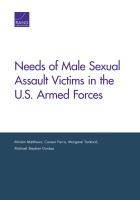| 来源类型 | Research Reports
|
| 规范类型 | 报告
|
| DOI | https://doi.org/10.7249/RR2167
|
| ISBN | 9781977400314
|
| 来源ID | RR-2167-OSD
|
| Needs of Male Sexual Assault Victims in the U.S. Armed Forces |
| Miriam Matthews; Coreen Farris; Margaret Tankard; Michael Stephen Dunbar
|
| 发表日期 | 2018
|
| 出版年 | 2018
|
| 页码 | 108
|
| 语种 | 英语
|
| 结论 |
Review of Published Research- Researchers recently estimated that 1.7 percent of civilian men have experienced an attempted or completed rape in their lifetime. Research estimates suggest that 2.2 percent of U.S. active-duty men have experienced a sexual assault in their lifetime, and 1.8 percent have experienced a sexual assault since joining the military.
- Many male sexual assault victims experience symptoms of depression, anxiety, nightmares, flashbacks, self-blame, low self-esteem, or problems with anger control following the assault.
- Estimates suggest that only 15 percent of military male sexual assault victims file a report, which appears to be consistent with levels of civilian reporting.
Interviews with Military Service Providers and Civilian Experts- Interviewees emphasized the mental health care needs of sexual assault victims. Several service providers believed that additional male-specific mental health services are needed in the military system.
- Most service providers believed that individuals in their profession were either somewhat informed or well informed about sexual assault against men in the military. However, few chaplains believed that those in the chaplaincy were prepared to assist male victims.
- Interviewees discussed multiple barriers to reporting among male sexual assault victims. For example, some male victims do not classify what happened to them as a "sexual assault." Other barriers included shame and embarrassment, a belief that nothing would be done, concerns regarding privacy, and concerns regarding harm to a military unit.
- Some service providers indicated that servicemembers maintain beliefs in false rape myths regarding male sexual assault, even after receiving sexual assault prevention training.
|
| 摘要 |
- Better educate military service providers on how to provide gender-responsive support to male sexual assault victims.
- Promote male victim reporting by ensuring that reporting is safe and confidential.
- Change outreach to better address the needs and concerns of male sexual assault victims.
- When educating servicemembers on sexual assault prevention and response, use an engaging format that includes information on the characteristics of male sexual assault.
- Educate commanders on how to respond to male sexual assault and how to interact with male victims.
- Consider development and evaluation of additional counseling services that address the mental health care needs of male sexual assault victims in the military.
- Support additional research that addresses the effects of training, outreach, and services addressing male sexual assault.
|
| 主题 | Male Populations
; Military Health and Health Care
; Military Personnel
; Sexual Assault
; United States Department of Defense
|
| URL | https://www.rand.org/pubs/research_reports/RR2167.html
|
| 来源智库 | RAND Corporation (United States)
|
| 引用统计 |
|
| 资源类型 | 智库出版物
|
| 条目标识符 | http://119.78.100.153/handle/2XGU8XDN/108759
|
推荐引用方式
GB/T 7714 |
Miriam Matthews,Coreen Farris,Margaret Tankard,et al. Needs of Male Sexual Assault Victims in the U.S. Armed Forces. 2018.
|
|
文件名:
|
x1525179170717.jpg
|
|
格式:
|
JPEG
|

|
文件名:
|
RAND_RR2167.pdf
|
|
格式:
|
Adobe PDF
|
除非特别说明,本系统中所有内容都受版权保护,并保留所有权利。